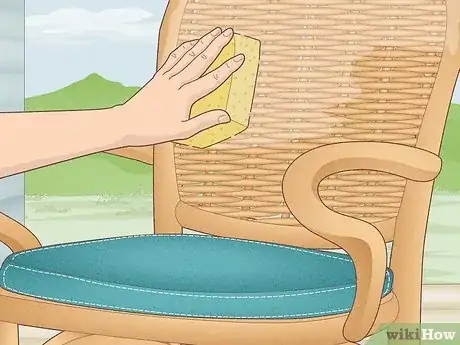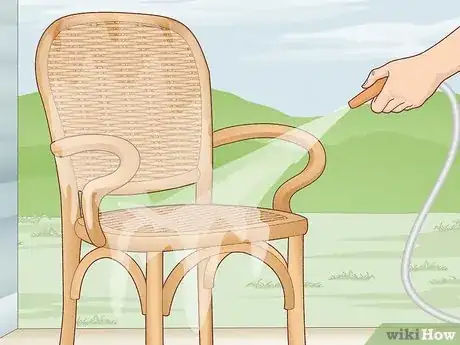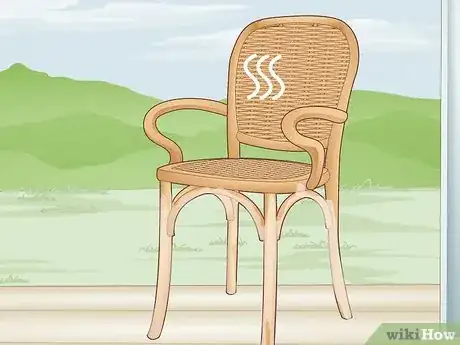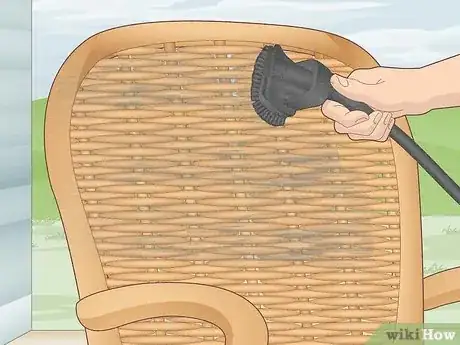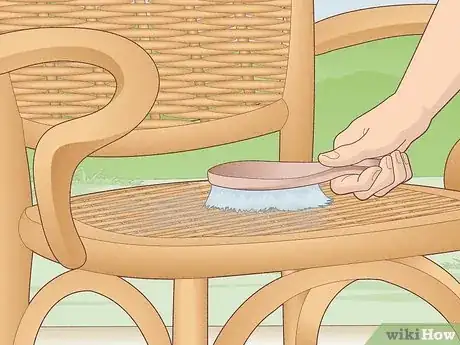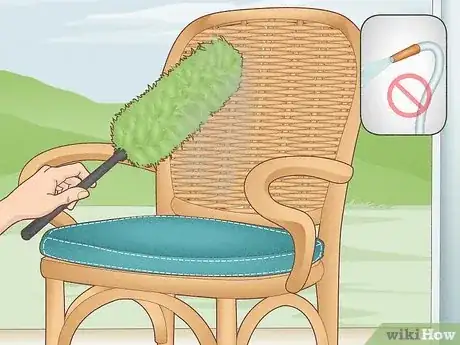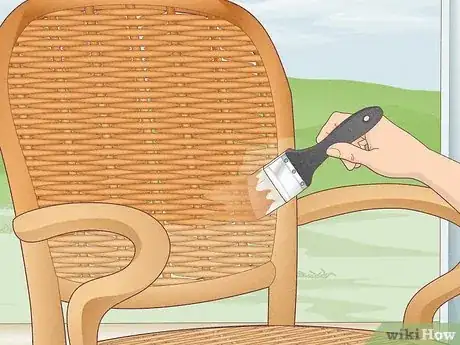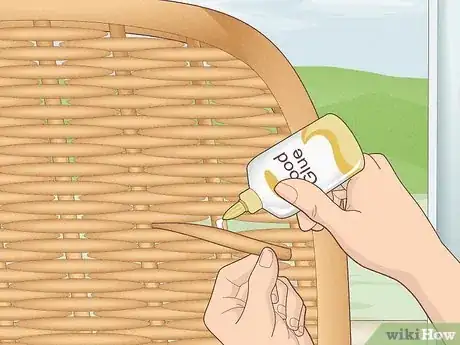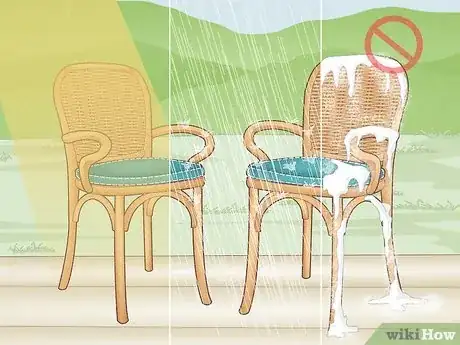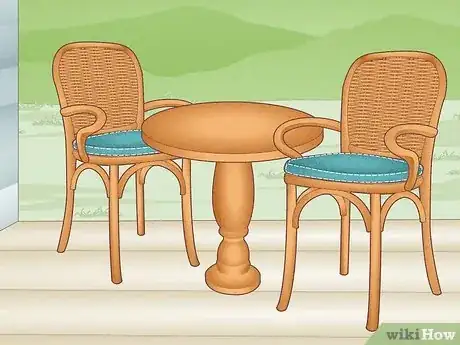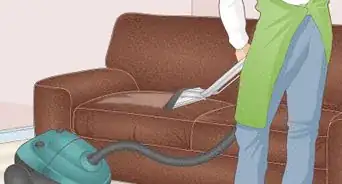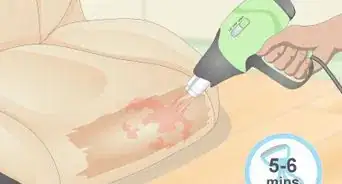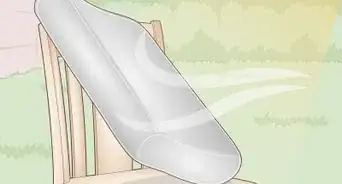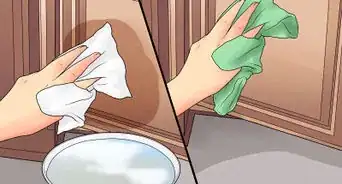This article was co-authored by Guy Peters. Guy Peters is the Owner of MOP STARS Cleaning Service, a complete house cleaning service for residential and commercial clients, based in Denver, Colorado. Founded in 2014, MOP STARS provides regular, move in/out, deep, and commercial cleaning services. Guy has a BA in Finance from the California State University - Sacramento and an MBA from Cornell University.
This article has been viewed 86,328 times.
Natural wicker furniture should be cared for and cleaned regularly to maintain its quality and shape. When washed, wicker can withstand moisture only to a limited extent before becoming loose or saggy, and attracting mildew growth. It's important to wash wicker properly to avoid this damage and keep your furniture looking like new.
Steps
Washing Wicker Furniture
-
1Wipe with a damp cloth or sponge. Use a soft cloth and water to gently wipe down all surfaces of wicker to remove dirt and retain shine.[1]
- Try using a mild soap on your cloth or sponge for more stubborn dirt and stains on your wicker, but follow by wiping with just water afterwards.
- You can also add salt to water as a non-abrasive way to gently scrub away dirt and stains.[2]
- Add a mixture of one part white vinegar to three parts water on your cloth if you need to eliminate mold or mildew built up on the wicker.[3]
-
2Wash cushions separately. Remove any cushions or other material that is not made of wicker and clean separately.
- Check to see if cushions have a tag with care instructions. You may be able to put the entire cushion, or a removable cover, into a washing machine.
- When in doubt, opt for gently dabbing at cushion fabric with a damp cloth and a small amount of gentle soap or stain remover.
Advertisement -
3Hose down outdoor wicker furniture. Wipe outdoor furniture with a wet cloth or sponge and soap, then rinse with a hose.[4]
- Never hose down paper fiber wicker, as it will easily be destroyed by a large amount of water. Washing should mainly be done with care on natural reed or synthetic wicker.[5]
- If possible, tilt your piece of furniture so that any area with a tighter weave of the wicker is on top. This way, water will run down from it to the looser weave, where it can be wiped away or dried more easily without keeping moisture trapped inside the weave.[6]
- Steam-clean outdoor wicker furniture with a hand steam-cleaner if it is very dirty. Make sure that you dry the wicker right away with a hair dryer or full sun and wind to avoid the wicker warping or bending.[7]
-
4Let the wicker dry. Ensure that the wicker is fully dry after washing and before replacing cushions or using the furniture again.[8]
- Keep the furniture in a dry place indoors, outside in the sun in dry conditions, or use a fan or hairdryer at some distance away from the wicker to accelerate drying.
- Keep the shape of the wicker as best as possible. Avoid sitting or placing any objects on the furniture before it is completely dry, as the wicker may form a new shape when wet.
- Expect to wait several days for the wicker to dry entirely.
Dusting and Brushing Wicker Furniture
-
1Dust with a feather duster or dry cloth. Use a microfiber duster, soft cloth, or feather duster to remove any dust or dirt that has accumulated on the surface.
- Try a duster with small nubs, feathers, or texture that will help get into the small cracks of the wicker weave.
-
2Vacuum with a brush attachment. Use a vacuum with a brush attachment on the hose to gently remove dust from on and inside the weave of your wicker.
- Make sure the vacuum is at a low suction setting to avoid damage, and brush it gently across the surface of the wicker.
- For larger dirt, dust, or other objects stuck in the wicker, try using a pair of tweezers or needle-nose pliers to remove it.
-
3Use a soft brush. Remove dust and dirt from between the weave of your wicker by sweeping a cleaning brush gently across the surface.[9]
- Try a paintbrush or even a toothbrush for smaller, hard-to-reach areas.[10]
- Make sure to use any brush lightly, so as not to disrupt or dislodge any of the wicker.
- Avoid steel wool or any brush with stiff bristles, as these can damage natural wicker or remove lacquer, paint, or weatherproofing from treated wicker.
Continuing Care for Wicker Furniture
-
1Wash as little as possible. Apply water to your furniture only when strictly necessary, sticking to dusting and vacuuming regularly when dust and dirt appear.
- A more thorough hose-down cleaning should only be needed about once a year, if that.[11]
- Do wash away spills and stains as soon as possible with a damp cloth and mild soap, as wicker will absorb any spilled moisture.[12]
- Use as little water as possible when you do need to use it, as more moisture will only damage the wicker further over time.
-
2Apply a lacquer to the wicker. Protect your furniture from damage by using a varnish, lacquer, or wax meant for use on wicker. Apply it in a thin layer with a brush or cloth, or in a spray form if possible.
- Try linseed oil or lemon oil as a natural method to help protect the wicker and boost its shine.
- Use a lacquer specifically meant for weatherproofing if you intend to start or continue using the wicker furniture outside.
-
3Repair wicker with wood glue. Apply a small amount of wood glue to any slats of the wicker that appear broken or fraying.
- You can also trim pieces of wicker that are frayed or broken and sticking out by using a pair of scissors to cut them away as cleanly as possible. Avoid pulling at any errant pieces.
- If damage is more extensive, you may need to take the furniture in to a professional, or replace it completely.
-
4Keep outdoor furniture out of the elements. Avoid direct sunlight, rain, snow, or heavy wind on your outdoor wicker furniture whenever possible.
- Cover or place your wicker furniture under a roof, deck, or canopy while not in use. You can also bring wicker furniture inside, if possible, to help preserve its life.
- Care for indoor furniture should also be taken by controlling humidity as best as possible. Use a humidifier in dry climates to avoid drying and cracking wicker, and use a dehumidifier or place wicker furniture in a room with good air circulation if in a very humid environment.[13]
-
5Finished.
Expert Q&A
-
QuestionCan you get wicker furniture wet?
 Guy PetersGuy Peters is the Owner of MOP STARS Cleaning Service, a complete house cleaning service for residential and commercial clients, based in Denver, Colorado. Founded in 2014, MOP STARS provides regular, move in/out, deep, and commercial cleaning services. Guy has a BA in Finance from the California State University - Sacramento and an MBA from Cornell University.
Guy PetersGuy Peters is the Owner of MOP STARS Cleaning Service, a complete house cleaning service for residential and commercial clients, based in Denver, Colorado. Founded in 2014, MOP STARS provides regular, move in/out, deep, and commercial cleaning services. Guy has a BA in Finance from the California State University - Sacramento and an MBA from Cornell University.
House Cleaning Professional Sure, but don’t go too far. In most cases, a dish soap and water solution is great for wicker furniture. Use a sponge or soft rag to apply the solution and avoid using anything too rough since most wicker can scratch easily.
Sure, but don’t go too far. In most cases, a dish soap and water solution is great for wicker furniture. Use a sponge or soft rag to apply the solution and avoid using anything too rough since most wicker can scratch easily. -
QuestionHow do you keep mold from growing on wicker?
 Guy PetersGuy Peters is the Owner of MOP STARS Cleaning Service, a complete house cleaning service for residential and commercial clients, based in Denver, Colorado. Founded in 2014, MOP STARS provides regular, move in/out, deep, and commercial cleaning services. Guy has a BA in Finance from the California State University - Sacramento and an MBA from Cornell University.
Guy PetersGuy Peters is the Owner of MOP STARS Cleaning Service, a complete house cleaning service for residential and commercial clients, based in Denver, Colorado. Founded in 2014, MOP STARS provides regular, move in/out, deep, and commercial cleaning services. Guy has a BA in Finance from the California State University - Sacramento and an MBA from Cornell University.
House Cleaning Professional Clean it with a solution of 50% hydrogen peroxide and 50% water to remove mildew. This solution will also reduce the chances of it coming back.
Clean it with a solution of 50% hydrogen peroxide and 50% water to remove mildew. This solution will also reduce the chances of it coming back. -
QuestionCan you spray paint wicker successfully?
 Community AnswerYes. It needs to be clean and bone dry. Make sure to spray with primer first and let it cure before attempting to spray your color on.
Community AnswerYes. It needs to be clean and bone dry. Make sure to spray with primer first and let it cure before attempting to spray your color on.
References
- ↑ Guy Peters. House Cleaning Professional. Expert Interview. 12 July 2021.
- ↑ http://www.huffingtonpost.com/2012/09/13/how-to-clean-wicker-with-salt_n_1881136.html
- ↑ http://www.bobvila.com/articles/wicker-care/#.VxePJT_81vo
- ↑ Guy Peters. House Cleaning Professional. Expert Interview. 12 July 2021.
- ↑ http://www.wickerwoman.com/articles/wicker-furniture-care
- ↑ http://www.housecleaningcentral.com/en/cleaning-tips/furniture/wicker.html
- ↑ http://www.bobvila.com/articles/wicker-care/#.VxePJT_81vo
- ↑ Guy Peters. House Cleaning Professional. Expert Interview. 12 July 2021.
- ↑ Guy Peters. House Cleaning Professional. Expert Interview. 12 July 2021.
About This Article
Wicker furniture is easy to clean, but it’s important to use the right materials, since it can be fragile. Dust your furniture with a feather duster or a soft brush, which will get into the crevices between the weave. If the wicker is dirty, wipe it gently with a damp cloth or sponge. Only use soap for tough stains that you can’t get out with water. Try to use as little water as possible, since too much moisture can damage the wicker over time. Make sure you let your furniture dry before replacing any cushions or sitting on it so moisture doesn’t get trapped. This can take a couple of days, but you can speed up the process with a hair dryer or leaving it out in the sun. For more tips, including how to finish your wicker furniture to make it last longer, read on!
